Ozone in Earth's thin blanket
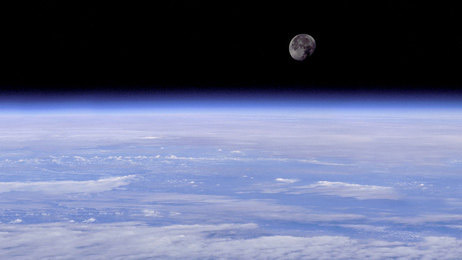
Sunlight filtered by the atmosphere
Not all of the sunlight from the sun makes it to the surface of Earth.
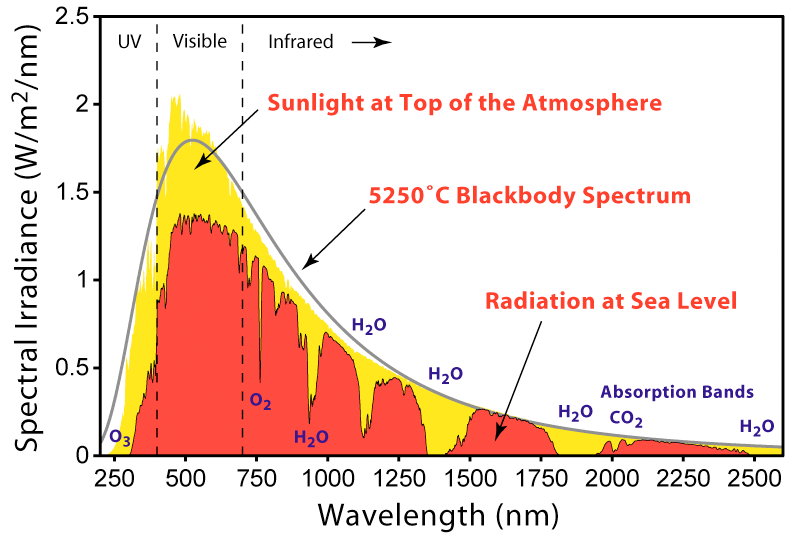
What's in air?
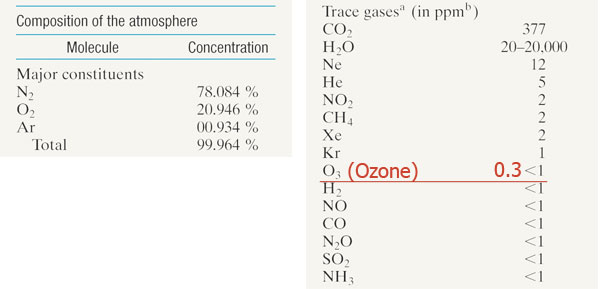
The Ozone layer
The SHIELD that protects us from ultra-violet (high energy) light from the sun...
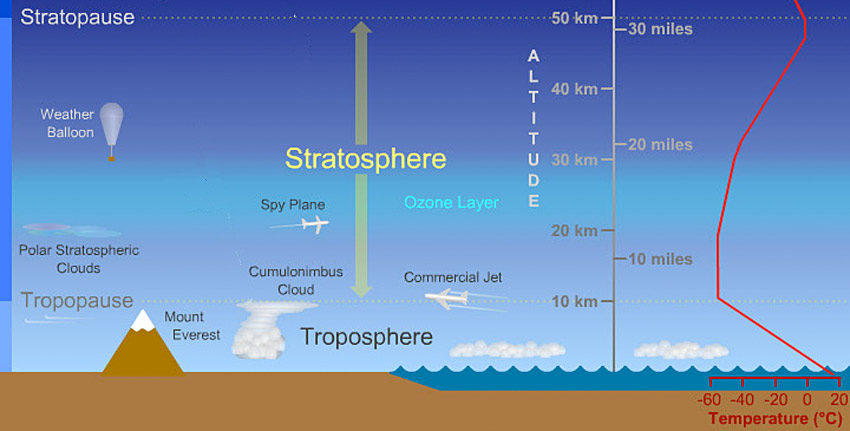
90% of Earth's air mass is within 10 km of the surface of Earth.
History of 'Freon'
Around 1900 - Refrigerators use toxic gases as coolants: methyl chloride, ammonia, sulfur dioxide.
Cracked pipes in your refrigerator? $\Rightarrow$ You die.
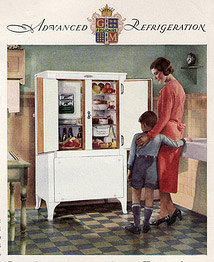 1928 -
GM chemists synthesize a chlorofluorocarbon (CFC), brand-named
"Freon" used first in Frigidaire refrigerators: non-toxic, non-corrosive, chemically
inert.
1928 -
GM chemists synthesize a chlorofluorocarbon (CFC), brand-named
"Freon" used first in Frigidaire refrigerators: non-toxic, non-corrosive, chemically
inert.
 Breathe it, and nothing happens to you! [This is CFC-12: dichlorodifluoromethane].
Breathe it, and nothing happens to you! [This is CFC-12: dichlorodifluoromethane].
1932 - Carrier uses Freon in its "Atmospheric Cabinet" - world's first self-contained home air-conditioner unit.
1945 - Freon used as the propellant in paints, hair sprays, health care products. Later, foam bubbling agent.
Where do the CFC's go?
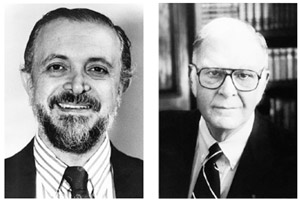 1974 -
Mario Molina and Sherwood Rowland suggested that CFCs could be broken apart
by high energy UV light, freeing
chlorine, which can then do this...
1974 -
Mario Molina and Sherwood Rowland suggested that CFCs could be broken apart
by high energy UV light, freeing
chlorine, which can then do this...
$Cl + O_3 \rightarrow ClO + O_2$
A second reaction frees the Cl to destroy anew...
$ClO + ClO + [UVl i g h t] \rightarrow Cl+Cl+O_2$
1978 - Consumer boycott leads to U.S. ban on CFCs in spray propellants.
Measuring ozone
Nowadays, there's a satellite that orbits Earth with the main purpose of measuring ozone. Go to ozonewatch.gsfc.nasa.gov. Watch together with someone else one of the mp4 movies.
- At what time of year is the amount of ozone lowest? (blue is low, purple is lower)
- Where is the ozone the lowest?
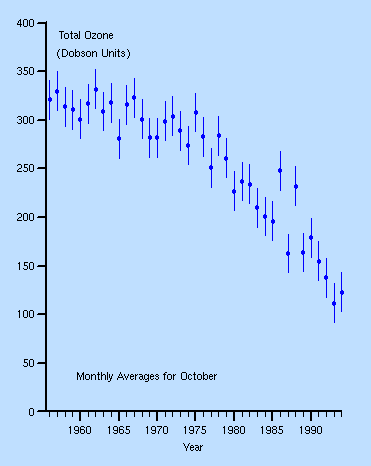 Before anyone was worried about ozone... English researchers at the Halley
Bay research station in Antarctica had been measuring ozone since the late
1950s. They couldn't quite believe the drop after ~1975, checked and re-checked,
and published in 1985.
Before anyone was worried about ozone... English researchers at the Halley
Bay research station in Antarctica had been measuring ozone since the late
1950s. They couldn't quite believe the drop after ~1975, checked and re-checked,
and published in 1985.
They also noticed a new seasonal effect: Each spring (October), the ozone would suddenly drop precipitously, and then recover a few months later.
Effects of elevated UV radiation
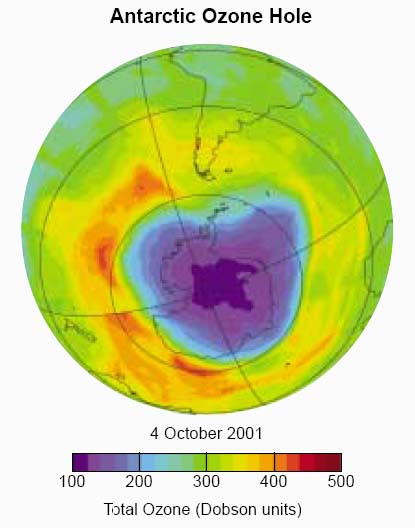 Hazards
of elevated UV radiation include
Hazards
of elevated UV radiation include
- Phytoplankton (sunlight-absorbing plankton) are vulnerable to UV, and are at the bottom of food webs in the oceans near Antarctica.
- Increased risk of skin cancer and cataracts in humans.
- Genetic damage to plants and animals.
The smoking gun
 1986 -
Susan Solomon organized an expedition to measure ClO.She proposes that stratospheric
ice breaks up enclosed CFCs, releasing Cl when heated by springtime sunlight.
1986 -
Susan Solomon organized an expedition to measure ClO.She proposes that stratospheric
ice breaks up enclosed CFCs, releasing Cl when heated by springtime sunlight.
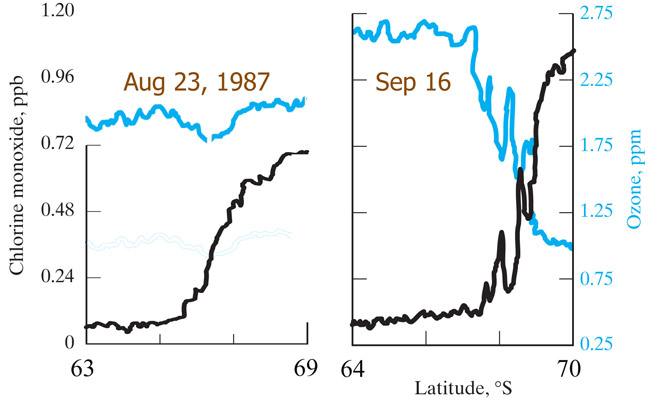
Montreal Protocol
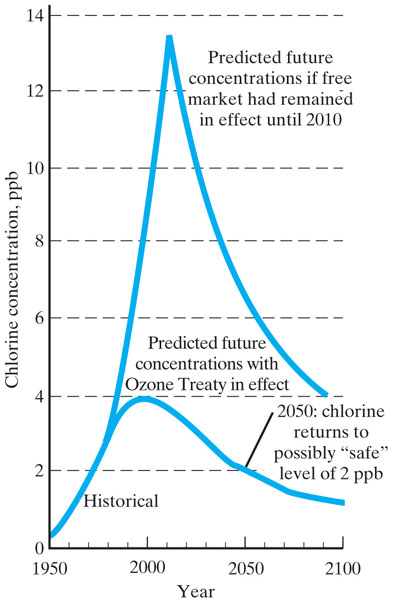 1987 -
24 nations signed the Montreal Protocol.
1987 -
24 nations signed the Montreal Protocol.
Republican President Ronald Reagan recommended the treaty for U.S. Senate approval.
As of Sept
2009, all 196 member states of the UN had signed on to the treaty to phase
out ozone-destroying chemicals.
1995 - Nobel prize in Chemistry goes to Paul Crutzen, Mario Molina
and Sherwood Rowland. The committee commends them for "contribut[ing]
to our salvation from a global environmental problem that could have catastrophic
consequences."
(NASA's The World We Avoided website modelled unregulated, 3% annual growth in CFC emissions, and concluded that Earth would have lost 67% of our ozone, and UV radiation at Earth's surface would have doubled by 2065).
CFCs have an estimated 40 year lifetime in the atmosphere and GWPs of 5000 and up.
- EPA table of GWPs and ODPs (Ozone Destroying Potential).
CFCs after Montreal were largely replaced by HFCs (HydroFluoroCarbons) -- which have an ODP$\approx 0$--Yaaaay!.
What kinds of GWP (Global Warming Potential) do HFCs have?
Unfortunately, most HFCs have GWPs of 1,000 and up (Australian Ag Water Env)--Boooo!.
The 2016 Kigali Amendment (signed by 170+ countries) to the Montreal Protocol aims to phase out HFCs by 2047.
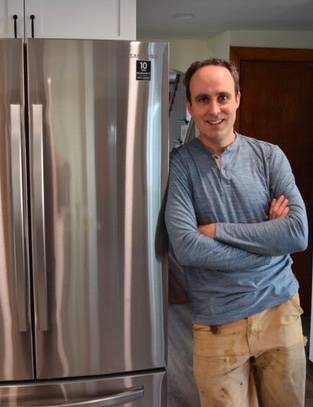 What refrigerant comes next? Some refrigerators are already selling models with isobutane (GWP~1). But it's a bit of a challenge to find: Phil McKenna tries, and eveeeeeentually succeeds, to buy a non-HFC refrigerator (March 2021).
What refrigerant comes next? Some refrigerators are already selling models with isobutane (GWP~1). But it's a bit of a challenge to find: Phil McKenna tries, and eveeeeeentually succeeds, to buy a non-HFC refrigerator (March 2021).
Image credits
Solar spectrum - Globalwarmingart.com, Windows to the Universe, Jason Swaby, IPCC